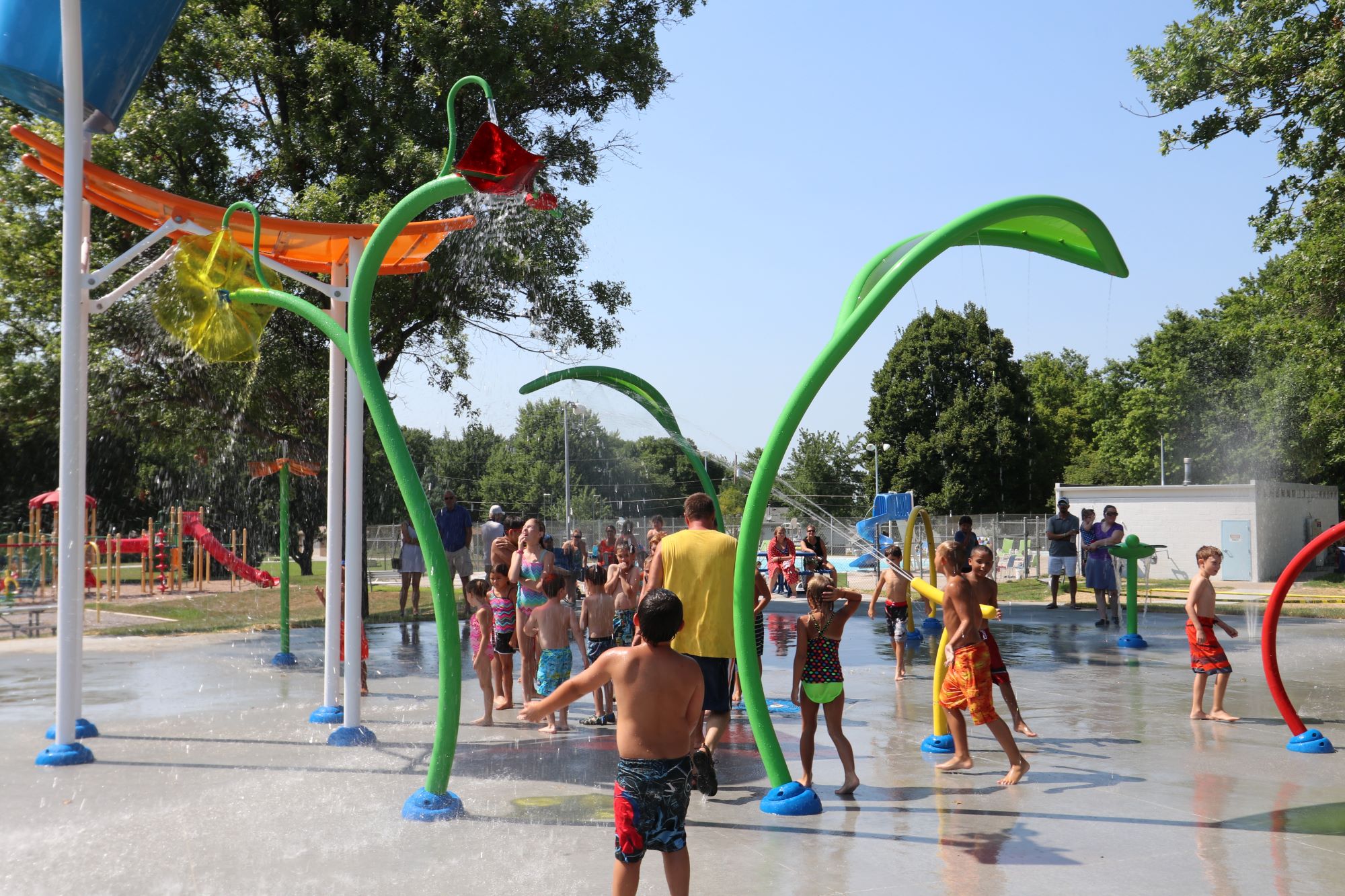Spray pads seem to be on the rise.
When these largely commercial features became more regulated a few years ago, with many states and municipalities requiring secondary sanitation systems, they had seemed to fall a bit out of favor, with people turning away at the cost, says Justin Caron, principal/CEO of San Diego-based Aquatic Design Group.
But now, with the current lifeguard shortage and rising wages for those who do choose the job, splash pads are showing up in more plans because they require few to no guards. People also are attracted by the fun factor, Caron says. And today’s vibrantly colored safety surfaces have amped their design.
Spray pads, also called splash pads, make great community builders, as they can bring people together and even create educational experiences.
“I see them as potential to create additional common spaces within a community for neighbors and families of a variety of backgrounds to come together and engage in a variety of social aspects,” says Amber Wyatt, a creative project manager for JEO Consulting Group in Overland Park, Kan. “They can also be a beacon for visitors from other cities or towns to travel in and explore a new place, which can support economic development.”
Here, commercial and aquatics designers share their tips for designing and installing these features, whichever term you use for them.
1. Don’t be lulled into this popular false impression.
It’s true that splash pads have little to no depth and, in many cases, are smaller than pools. But don’t confuse that to mean they’re simpler than pools. These systems are as complex, if not more so, and they require meticulous design and construction.
“[People] look at a splash pad and say, ‘It’s just this shallow thing with these neat little toys,’” says Matthew Freeby, a project director with Water Technology Inc. (WTI), an aquatics and waterpark designer/builder in Beaver Dam, Wisc. “In actuality they can be more complex than a pool. Where a pool has a body of water and then filtration, perhaps heating and chemical treatment on a very basic level, a splash pad can have all that, plus controls activating toys and misting sprays, timers and lights and other features. So they can get complex very quickly.”
Additionally, these features are considered more at risk for carrying waterborne pathogens, because of their relatively low volumes and potential exposure to human waste, as young children are often the primary users. So, in many jurisdictions, they require secondary sanitation and controllers to maintain proper water quality.
This complexity translates to their operation, as well, lest any clients believe they will be simpler to care for than a pool, adds Ryan Nachreiner, another WTI project director. The chemistry needs to be pristine.
“So you need an operator who is aware and understands the complexities of the chemistry and water balance of a pool and splash pad system,” he says.
For the designer, this means that emphasis should be placed on ease of operation and maintenance when choosing, sizing and placing equipment and features.
In approaching the design of spray pads, some professionals overlook something integral to many pools — a geotechnical report and structural engineering, Wyatt says.
While these structures don’t reach several feet into the ground, they still will be impacted if built on improper fill, plus holding tanks can be affected by such things as high groundwater and expansive soil. Foundations also should be properly engineered for spray pads, as surely as they would be for pools.
Wyatt finds that some clients also overlook the needed support amenities that should accompany spray pads. These are similar to those built with many commercial pools. At the very least, this should include adjacent seating areas — preferably shaded — for parents and guardians to watch their charges. But for larger-scale projects, things such as restrooms, parking and pedestrian connection points should be included.
When dealing with clients and potential clients, you may run into a related misperception: That spray pads are much less expensive than they are. But, given rising costs, the intricacy of these features, and the increasingly stringent codes being applied to them, the price tag is steeper than expected.
People may believe they should be able to have a commercial spray pad for $150,000, when the structure, sanitation and hydraulic systems can add up to twice that amount, before the sprays and toys are included, Caron says.
2. Honor the contours
Several aspects of splash pads add to their complexity. One part especially needs meticulous attention — the contours of the floor.
Because the features have little to no water depth, the drainage and hydraulics system relies heavily on the floor’s sloping and contouring to capture and channel the splash and runoff.
This must be accomplished while simultaneously complying with accessibility laws and codes.
“All pool decks — splash pads included — need slopes of 1% and no greater than 2%,”Caron says. “One percent is required to facilitate water to move toward the drains. Two percent is the maximum you can have for the Americans with Disabilities Act.”
Walking this particular tightrope requires carefully planned flooring contours.
“Because they’re not intended to hold water, you don’t have any forgiveness in the contours,” Freeby says. “You have to exercise much more care in the contouring design of the pad than you’d be used to in a pool. One-quarter inch can make a huge difference. I’ve seen where contours aren’t done property, then water runs off and you’re not capturing it.”
Besides trying to direct the water toward the drains, sometimes the floors are meant to channel the splash and falling water to form a stream that kids can follow. This requires very intentional engineering.
“You’re trying to do conflicting things,” Freeby says. “From a slope perspective for drainage, the steeper you make the slope the better it will drain. But from a practical standpoint for a user, if it’s steeper it’s more difficult to use, plus it might exceed requirements from an accessibility standpoint. You have conflicting requirements and so it’s a balance — and that balance is very tight.”
3. Include a wind gauge.
With most or all the water in a splash pad system going airborne at some point, the systems should be set up to turn off in the case of high winds.
“If the wind gets too high and you have water in the air, it can be moved off the deck and it can’t be captured,” Freeby says.
Be sure to include a wind gauge, known as an anemometer, into the system.
More sophisticated systems can turn certain features off at one threshold, then shut everything off at a higher wind speed. Simpler ones will just shut everything off when winds reach a certain point.
“If it’s windy, there aren’t many people at a spray pad anyway,” Freeby says.
There’s no hard and fast rule for what speeds should prompt the system to shut down. A popular threshold is 20 miles per hour, but that’s not always most appropriate.
It depends on the environmental conditions. If the spray pad is heavily shielded by trees, it may be immune to winds that the anemometer will detect. “But if you’re in the open prairie, you want it to shut off sooner,” Freeby says.
The design of the spray pad also can factor into the maximum wind speed to which it should be exposed, Nachreiner says. If it generates high volumes of water — say the pad is particularly expansive or features a high-volume dumping bucket or especially high sprays — then the splashout can reach farther than milder sprays, potentially saturating everything in the near vicinity, including innocent bystanders. In these cases, the shut-down should occur at lower wind speeds.
Once the system is set, operators should observe the splash pads during wind events, see if the shut-down speed makes sense, then make any adjustments if necessary, whether up or down.
4. Design for the overall experience.
Start by identifying your audience. If you want the pad to attract people at various stages of their lives, it’s best to create zones aimed at different age groups and abilities. Lower, gentler sprays go in areas for smaller children or those who experience sensory issues. Larger features pushing higher volumes will appeal to larger kids. This way, toddlers still gaining their footing can stay out of the way of older, more rambunctious kids.
Also think about the path you want it take, and the traffic flow. Is the spray pad meant to tell a story or impart a lesson that would help dictate the sequence by which the sprays should be experienced? Do you want an orderly path and traffic flow, or should children be able to randomly pinball between features?
“Are you designing it so it’s more of a circuit so there are different areas that they’re walking around and rotating?” Nachreiner asks. “Do you want it more chaotic where they’re going all over the place, or is there a central activity tower?”
5. Pay special attention to the surfaces.
The surfaces on spray pads become very important, as these features largely serve children, some of them still learning to walk, on a wet surface.
The surface should not be chosen based on cost alone. But those costs should be clear — not only the upfront price tag.
The market has seen the introduction of several surfaces made specifically for this market. Not only are they available in vibrant colors, but they’re generally very slip-resistant. These will cost more than concrete, not only upfront, but also in terms of maintenance and replacement. It’s hard to beat the durability of concrete.
But clients shouldn’t completely rule out using these surfaces. “Be strategic on where you use the different surfaces,” says Andrew Pennekamp, another creative project manager for JEO Consulting Group. “I can think of a few projects where there was a toddler area that received more of the safety [flooring], then the main body of the splash pad was concrete. That was one way of providing that protection without the expense of covering the whole splash pad [with the safety flooring].”
However, if using concrete, make sure the contractor installing it knows how to create a surface appropriate to this kind of application. They should understand how to place a strong concrete mix, and install things such as expansion joints to manage expansion and contraction.
Properly brooming the surface for an adequate slip coefficient is crucial. “We want to make sure it’s not so abrasive that it’s cutting feet but is textured enough to be slip-resistant,” Pennekamp says. To ensurer proper slip resistance, his company will have contractors put together a sample of the finished product.
They also should know better than to top it with sealers that will make the surface slick, Caron says.
6. Place features to control splash and spray.
Place each element to avoid spray going outside the perimeter of the splash pad.
Anything close to the edge should spray toward the center, so it doesn’t wet a surrounding deck or create muddy conditions. High-flow features such as buckets should stand toward the center of the splash pad. This way, when the higher volumes of water hit the ground, there’s plenty of room to capture it before it can flood perimeter drains.
Cannons and other elements that can be controlled by users to spray each other should be far enough away that they can’t hit passersby or adults watching their charges from the perimeter.
“You want to protect the innocent,” Caron says.
If the area has high winds, or winds that tend to blow in one direction, also keep this in mind when placing spray features.



